| Image | Plant | Status | Notes | Events |
|---|---|---|---|---|
 |
Voodoo Lily (Amorphophallus konjac) |
Have Plant Collected or purchased 2023 Tender Perennials Flowers Houseplants Part Sun Part Shade Full Shade Plants Successfully Growing |
J.H. Champaign IL 2023 |
June 26, 2023: Obtained plant (2 bulbs. One about the size of a quarter & sprouting & the other about the size of a dime & still dormant.) July 2, 2023: Plant emerged (One starting to emerge.) |
 |
Variegated Columbine (Aquilegia vulgaris 'Leprechaun Gold') |
Have OP Collected or purchased 2023 Perennials Flowers Full Sun Part Sun Part Shade Full Shade Stratify Direct Sow Winter Sow Sown 2023 Plants Successfully Growing |
BC 2023 Zones 4a-8b. |
February 28, 2023: Seeds sown (WS about 10.) March 25, 2024: Plant emerged (One plant that I had transplanted into the stump garden in October 2023. Something started to dig it up so I put a crate over it.) |
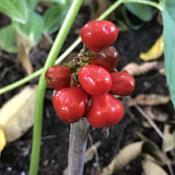 |
Arisaemas (Arisaema) |
Have Plant Collected or purchased 2023 Perennials Native Wildflowers Part Sun Full Shade Plants Successfully Growing |
2023 Chicagoland annual plant swap - Mone | May 14, 2023: Obtained plant May 15, 2023: Transplanted (Into the shade garden by the firepit.) |
 |
Jack in the Pulpit (Arisaema triphyllum) |
Have Perennials Edibles Native Wildflowers Part Shade Full Shade |
DND's All Seeds Swap #9 (2022) - SameOldBrandNew - 2021 G - These are from my garden but seeds are originally sourced from local woodlands. Named for its resemblance to a preacher in a canopied pulpit, Jack in the Pulpit grows wild in woodland and marsh areas and sends up its unique hooded flower in the spring. Though Native American tribes gathered and boiled the fleshy roots as a vegetable, eating the root raw causes a sensation similar to swallowing a mouthful of glass shards. This sensation is caused by the calcium oxalate crystals in the plant, which protect it from predatory animals. The faint odor, however, attracts pollinating insects to the flowering spadix, or "Jack." Early Americans found many uses for this plant, including making poultices to reduce inflammation or grinding the dried roots for flour or starch. Sowing: To break its dormancy this Jack in the pulpit seed needs a period of cold moisture, a period of warm moisture, followed by another period of cold moisture. Mix the seed with moist sand and store it in the refrigerator for 60 days, then move it to a 70-75 degrees F location for 30-60 days, followed by another 30-60 day period in the refrigerator before planting. To accomplish this naturally, simply plant the Arisaema Triphyllum seed in late fall and wait until the second spring after planting for germination. In late fall or early spring, direct sow the treated seed 1/4" deep. Germination should take place within 14-20 days. Growing: This plant grows best in moist soil and dappled shade. They grow very slowly, producing only one or two sets of leaves in their first season and flowering after about five years. For the best growth, keep the soil moist and covered by a layer of leaf mulch. This plant will spread over time, eventually forming a colony that will last for many years; the ripe berries will drop and germinate well in the following spring. Birds and mammals are attracted to the berries, which develop after the flower fades. Deer avoid this plant. Harvesting: All parts of this plant should be considered poisonous since they cause a painful burning sensation and blisters when touched or ingested. Seed Saving: Jack-in-the-Pulpit plants can become male or female depending on their environment. After the hooded female flower fades, a large cluster of red berries will form; each berry contains several seeds. Wearing gloves, gather the berries and smash them in a large container. Rinse the mixture in a strainer, removing as much of the pulp as possible until only Arisaema Triphyllum seeds are left. For best germination, do not allow the Jack in the pulpit seeds to dry; mix them with moist sand and keep them in the refrigerator until planting. It thrives in USDA Hardiness Zones 4 to 9. Jack in the pulpit prefers part to full shade and fertile, evenly moist soil. |
February 15, 2023: Seeds sown (WS 10.) |
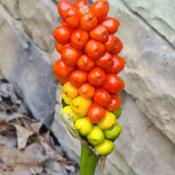 |
Italian Arum (Arum italicum) |
Have Plant OP Collected or purchased 2023 Perennials Flowers Native Wildflowers Part Shade Full Shade Winter Sow Sown 2023 Plants Successfully Growing |
K. C. Buffalo NY 2023 - seeds did not germinate. 2023 Chicagoland annual plant swap - Mone |
February 28, 2023: Seeds sown (WS all 6 seeds.) May 14, 2023: Obtained plant May 15, 2023: Transplanted (Into the shade garden by the firepit.) |
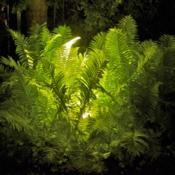 |
Lady Fern (Athyrium filix-femina) |
Have ***** Plant Collected or purchased 2022 Perennials Ferns Native Wildflowers Part Sun Full Shade Plants Successfully Growing |
Chicagoland-Annual-Plant-Swap 2022 lovesoil In Shade Garden One 2022-2024. Zones 3-8. |
May 14, 2022: Obtained plant (Chicagoland Annual Plant Swap 2022 lovesoil ) May 26, 2022: Transplanted (Into Shade Garden One) |
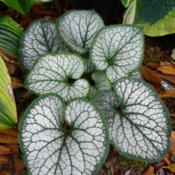 |
Silver Siberian bugloss (Brunnera macrophylla 'Jack Frost') |
Have Perennials Flowers Part Shade Full Shade Stratify Winter Sow |
DND's All Seeds Swap #9 (2022) - RoseA32 - 2022G Sow out stratified Brunnera seeds ten weeks in advance. Transplant outdoors following the last frost or in autumn. Requirements: Full sunlight or partial shade. Grows in most soils; for best results: Soil pH 5.5 to 7.0, rich soil, moist soil. hardy in zones 3 - 8 |
|
 |
Basket Plant (Callisia fragrans) |
Have Trade as plant Sell as plant Tender Perennials Houseplants Tropicals Full Sun Part Sun Part Shade Full Shade Plants Successfully Growing |
Given to me by my friend Wayne in Mississippi 2017. | May 4, 2017: Obtained plant (Wayne 2017) May 4, 2022: Bloomed (First time this plant has bloomed for me.) |
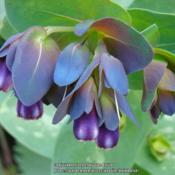 |
Honeywort (Cerinthe major subsp. purpurascens) |
Have Plant Seeds OP Collected or purchased 2021 Annuals Edibles Flowers Greens Full Sun Part Sun Part Shade Full Shade Sow Indoors Under Lights Sow in Unheated Greenhouse Winter Sow Sown 2023 Plants Successfully Growing |
From STSTS Swap 2-2021 |
April 10, 2023: Seeds sown April 13, 2023: Plant emerged (6 total.) June 15, 2023: Transplanted (8 Into shade Garden by the pond.) |
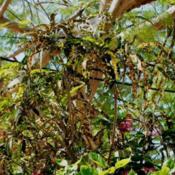 |
Garden Croton (Codiaeum variegatum var. variegatum) |
Have Tender Perennials Houseplants Trees & Shrubs Full Sun Part Sun Part Shade Full Shade Sow Indoors Under Lights |
DND's All Seeds Swap #9 (2022) - GardenQuilts | December 6, 2022: Seeds sown (Pods were wet & moldy. Two seeds look like they might be viable. Hoping for at least one to germinate.) December 17, 2022: Plant emerged (2 seedlings (I think).) |
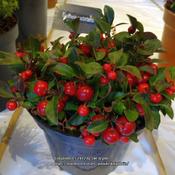 |
Wintergreen (Gaultheria procumbens) |
Have Collected or purchased 2023 Perennials Edibles Tea Native Wildflowers Fruits & Vegetables Part Sun Part Shade Full Shade Winter Sow Sown 2023 |
twf - 2023 A strongly aromatic edible and ornamental plant native to North America. The pretty red fruits are scented and flavored of wintergreen and the leaves, used in teas, contain wintergreen oil as well. Low growing, to only 6". Also quite pretty as an ornamental. Grows well in shade or filtered sun. Native to northeastern North America from Newfoundland west to southeastern Manitoba, and south to Alabama. Zones 3 – 9. |
March 2, 2023: Seeds sown (WS several.) |
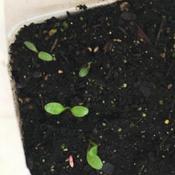 |
Leopard Plant (Ligularia 'BBQ Banana') |
Have Collected or purchased 2023 Perennials Flowers Part Shade Full Shade Winter Sow Sown 2023 |
Ligularia dentata 'BBQ Banana' K. C. Buffalo NY 2023 |
February 15, 2023: Seeds sown (WS 10.) April 12, 2023: Plant emerged (A few seedlings have emerged.) |
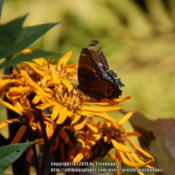 |
Leopard Plant (Ligularia dentata 'Desdemona') |
Have Perennials Flowers Part Shade Full Shade Plants Successfully Growing |
6th Annual NFTSRSS - Maulwurf - 2021 Chicagoland-Annual-Plant-Swap 2022 LinneaL - Plant emerged April 2023. DND's All Seeds Swap #9 (2022) - Maulwurf Best grown in humusy, organically rich, medium to wet soils in part shade to full shade. Must have moist soils that never dry out. Benefits from a regular, deep watering in hot summers. Foliage will wilt in too much sun. Needs a shaded location. Site plants in areas protected from strong winds. Native to China and Japan. Zones: 3-8. |
February 21, 2022: Seeds sown (Winter sowed. Jug 8.) |
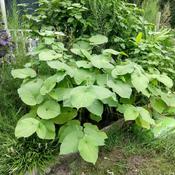 |
Root Beer Plant (Piper auritum) |
Have Collected or purchased 2023 Tender Perennials Edibles Part Shade Full Shade |
twf - 2023 Large-leafed perennial is related to the pepper plant. Known for its leaves, which are used for their spicy aromatic scent and flavor, some liken to root beer, others to anise-clove. Shrubby perennial to 6+ft. This species is easily identified by its huge leaves which can grow over a foot long in older specimens. Plants will grow out from roots so they can spread in ideal conditions. Flowers are long, skinny, white, and fuzzy looking. They may be borne in season. The plant doesn't usually form many fruits outside of its native range. The leaves are chopped and used for flavoring, as well as used whole, as wrappings for meats, tamales, etc. Main foliage is hardy to about 32F but will die back in colder areas and re-grow from roots. The root system is probably hardy to 15-20F. Native to Mexico through Colombia. Zones 8-11. |
|
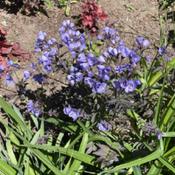 |
Jacob's Ladder (Polemonium caeruleum) |
Have Seeds OP Collected or purchased 2024 Perennials Medicinal Flowers Part Sun Full Shade |
EARLY SPRING SEED EXTRAVAGANZA #1 - 2024 - Maulwurf 200 days Zones 4 - 9. |
|
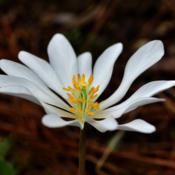 |
Bloodroot (Sanguinaria canadensis) |
Have Plant Collected or purchased 2023 Perennials Native Wildflowers Part Shade Full Shade Plants Successfully Growing |
2023 Chicagoland annual plant swap - Mone | May 14, 2023: Obtained plant May 15, 2023: Transplanted (Into the shade garden by the firepit.) |
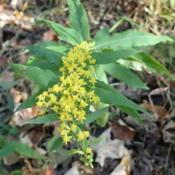 |
Bluestem Goldenrod (Solidago caesia) |
Have Seeds Collected or purchased 2024 Flowers Native Wildflowers Herbs Full Sun Part Sun Part Shade Full Shade Stratify Needs Light |
EARLY SPRING SEED EXTRAVAGANZA #1 - 2024 - mmolyson - 2023 Keystone species host to the Wavy-lined Emerald. Not aggressive. Stratify 60 days. 2-5 years to maturity. |
|
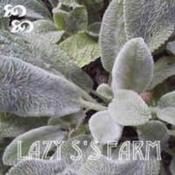 |
Lamb's Ears (Stachys byzantina 'Silver Carpet') |
Have Perennials Part Sun Part Shade Full Shade |
DND's All Seeds Swap #9 (2022) - DeerXing - 2022 as shown. Silver Carpet Lamb's Ear (Stachys byzantina Silver Carpet) is a handsome, fuzzy, grey-leaved ground cover that thrives in problem areas such as dry shade and poor soils. Silver Carpet Lamb's Ear is a drought-resistant (xeric), non-flowering perennial plant. 4-6" tall. 18-30" wide. Non-flowering variety. Zones: 4 - 8. |
|
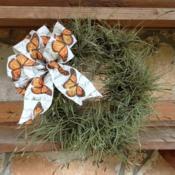 |
Ball Moss (Tillandsia recurvata) |
Have Plant Collected or purchased 2024 Collected or purchased 2022 Tender Perennials Bromelaids Flowers Part Shade Full Shade |
DND's All Seeds Swap #9 (2022) - GardenQuilts - Two tiny or One small plant (2-3") squished in a little ziploc. I'll gather shortly before sending and squish them into ziploc at the last minute. Open right away! EARLY SPRING SEED EXTRAVAGANZA #1 - 2024 - GardenQuilts - Two tiny or One small plant (2-3") squished in a little ziploc. I'll gather shortly before sending and squish them into ziploc at the last minute. Open right away! - Did not send in to the swap. Tillandsia recurvata is native to the southern US. Zones 8a-11. |